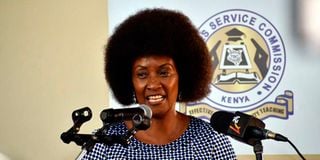Premium
Shock as 356,000 jobless tutors apply for 14,000 teacher vacancies

Teachers Service Commission CEO Dr Nancy Macharia during the launch of Competency Based Curriculum (CBC) training for over 60,000 secondary school teachers at the Kenya Institute of Special Education on April 26, 2022.
The unemployment crisis in the country has reared its head with over 356,000 jobless teachers putting in applications for the 14,000 jobs advertised by the Teachers Service Commission (TSC) last month.
The high number of applicants sets the stage for a stiff recruitment exercise that will also leave hundreds of thousands dejected by failure to secure jobs. This is despite there being an acute teacher shortage in public primary and secondary schools.
According to a TSC roadmap for the recruitment, the online application process closed on July 7 after which the candidates who will have been shortlisted will be published on the TSC website. This is expected to be done anytime this week.
The Nation understands that, for each of the advertised positions, only the top five candidates will be shortlisted, in a departure from the past when long merit lists would be developed although only a few stood a chance of getting the job.
“However, some areas like in the Asal [arid and semi arid lands] zones might have fewer applicants,” a source said. TSC intends to complete the selection process and handling of complaints in the next two weeks before the successful candidates report to schools on September 1 2022.
Post-primary teaching vacancies attracted the highest number of applicants with 219,311 teachers expressing interest in the 4,000 new vacancies available. Out of the advertised 1,000 new vacancies for primary school teachers, the commission received 136,833 applications. Shortlisted candidates will be recruited at the county level before being posted to their respective schools.
TSC has also advertised 8,230 vacancies to replace teachers who have quit the service through natural attrition. The vacancies are both in primary schools (6,539) and post-primary institutions (1,691) and attracted 327,882 applications. Through affirmative action, TSC advertised for some positions specifically targeting Mandera, Garissa and Wajir counties, which are heavily understaffed. Teachers from other regions have in recent years resisted deployment in the region due to insecurity where non-locals are often targeted.
TSC intends to deploy 1,230 teachers in the region on both permanent and pensionable and contractual basis. Applicants who have expressed interest in the jobs are 21,194.
“To qualify for recruitment, a candidate must be teaching under board of management in Garissa, Mandera or Wajir counties, if not hailing from the three counties,” said Dr Nancy Macharia, the TSC chief executive, when declaring the vacancies. This is to encourage teachers from the region to apply for the jobs.
Dr Macharia added that the merit lists that will be generated during the exercise will be used in subsequent recruitment within the financial year.
The recruitment comes at a time when leading political players are capitalising on the situation to promise trained but jobless teachers jobs if they win.
Azimio la Umoja One Kenya Coalition Party presidential candidate Raila Odinga has promised to employ all jobless teachers if he wins while his main rival, Deputy President William Ruto of the United Democratic Alliance has promised to employ 116,000 teachers in two years.
Joblessness among professionals despite chronic under-staffing is not only in the education sector . Although public medical facilities are understaffed, there thousands of medics who are either jobless or under-employed.
In 2018, Kenyan doctors sued the government for hiring doctors from Cuba while many of them remained without jobs. In the petition, the doctors claimed to have been representing about 1,300 of their qualified and licensed but jobless colleagues.
They also contested that the Cuban doctors would be offered better packages than Kenyan medical practitioners with similar skills and proficiency. The case was however dismissed by Justice Onesmus Makau.
According to the Kenya National Bureau of Statistics, youths in the 20 to 24 and 25 to 29 age brackets have the highest proportion of the unemployed at 16.3 per cent and 9.1 per cent respectively.





